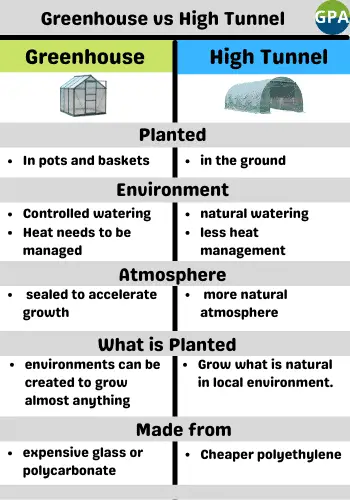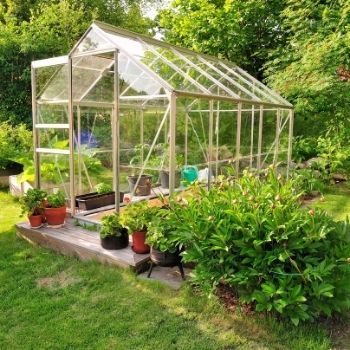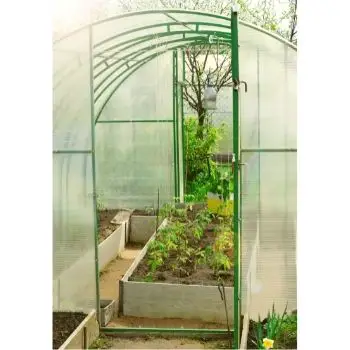Greenhouses and high tunnels are both structures used for agriculture, but they have some key differences. Which one is right for you? Let’s take a closer look at the pros and cons of a greenhouse vs high Tunnel.
Greenhouses are sealed, insulated, and transparent rooms that use light to heat themselves up, and a controlled environment to stimulate the growth of plants. High tunnels are open-faced covers for gardens and crops that keep plants healthy and protected.
Keep reading as we break down the key difference between both and explain to you which is better and why.
- Difference between a greenhouse and a high tunnel
- Which is better, greenhouse or high tunnel
- Is a polytunnel warmer than a greenhouse
- Is a high tunnel the same as a greenhouse
- A detailed look at the difference between a Greenhouse vs High Tunnel
- Greenhouse vs High tunnels – Lifespan
- Greenhouse vs High tunnels – Construction
- Greenhouse vs High tunnels – How they plant
- Greenhouse vs High tunnels – Controlled environment
- Greenhouse vs High tunnels – How they are made
- Greenhouse vs High tunnels – Temperature control
- Greenhouse vs High tunnels – Cost
- Greenhouse vs High tunnels – Ventilation
- Greenhouse vs High tunnels – Protection from pests and diseases
- Greenhouse vs High tunnels – What to grow
- Conclusion
Difference between a greenhouse and a high tunnel
A greenhouse is typically an enclosed space that is used to grow plants. A high tunnel is a type of greenhouse that has a metal or plastic frame and is covered with a layer of polyethylene film.
- High tunnels are typically used to protect crops from the elements and extend the growing season.
- greenhouses are typically used to grow plants that require a controlled environment, such as tropical plants.

Which is better, greenhouse or high tunnel
There are pros and cons to both greenhouse and high tunnel production. Greenhouses offer a longer season for crop production and can be used to produce off-season crops.
High tunnels, also known as polytunnels, provide some protection from the elements but are not as effective in extending the season. Ultimately, the best option for you will depend on your specific production goals.
Is a polytunnel warmer than a greenhouse
The main difference between a polytunnel and a greenhouse is that a polytunnel has no solid walls or roof.
This means that there is more airflow and ventilation in a polytunnel, which can make it feel cooler than a greenhouse.

However, the extra ventilation also means that heat escapes more easily, so in general, a polytunnel will not be as warm as a greenhouse.
polytunnels are more effective in warmer climates, whereas greenhouses are better suited to cooler climates.
Is a high tunnel the same as a greenhouse
No, a high tunnel (AKA Polytunnel ) is not the same as a greenhouse. A high tunnel is an unheated structure that is typically used to extend the growing season for crops. Greenhouses are typically heated and can be used for year-round production.
A detailed look at the difference between a Greenhouse vs High Tunnel
Below we will take a more detailed look at the key points that differentiate a polytunnel (or high tunnel) from a traditional greenhouse.
Armed with this knowledge, you will be able to make a more informed decision about which type of structure is right for your needs.
Greenhouse vs High tunnels – Lifespan
Polytunnels have a shorter lifespan than greenhouses. They are typically made from polyethylene, which has a limited lifespan of 5-8 years.
Greenhouses, on the other hand, are built to last. They are made from stronger materials like glass or polycarbonate, which can last for decades.
Greenhouse vs High tunnels – Construction
Polytunnels are much easier and cheaper to construct than greenhouses. They can be built using metal or plastic frames and covered with a layer of polyethylene film.
Greenhouses, on the other hand, are typically made from glass or polycarbonate, which makes them more expensive and difficult to construct.

On top of that, you may also need to have a foundation built to house a greenhouse, which comes with additional costs.
This makes greenhouses more permanent and high tunnels more portable.
Greenhouse vs High tunnels – How they plant
In a greenhouse, plants are planted in pots, troughs, and baskets. Essentially, any container that can hold them and keep water in.
They are kept in their own little environments on the elevated, artificial ground by these receptacles where their nutrition and water intake can be carefully controlled.
High tunnels crops are planted directly into the ground. This makes high tunnels more similar to traditional gardens, where all your plants are sharing the same, naturally occurring soil.
Greenhouse vs High tunnels – Controlled environment
High tunnels are grown using the nutrients and water from the ground. You will have little control over this, but you can supplement their water and nutrients.
Greenhouses however have complete and utter control over their environment. This includes the air quality, temperature, humidity, watering, and nutrient levels.
Greenhouse vs High tunnels – How they are made
Polytunnels are typically made from a steel frame covered with polyethylene. Greenhouses can be made from a variety of materials, but the most common are glass or polycarbonate.
Greenhouse vs High tunnels – Temperature control
Polytunnels are not as effective at controlling temperature as greenhouses. This is because they are not as well insulated and don’t have the same level of ventilation.
As a result, polytunnels are more likely to experience extremes of temperature, both in winter and summer. Greenhouses, on the other hand, are better at maintaining a stable temperature.
Greenhouse vs High tunnels – Cost
Polytunnels are usually cheaper than greenhouses. This is because they are simpler structures made from less expensive materials.
Greenhouses, on the other hand, can be more expensive to build and maintain.
Greenhouse vs High tunnels – Ventilation
Polytunnels have much better ventilation than greenhouses. This is because they are not completely sealed like greenhouses and have vents or roll-up sides that can be opened to allow air to circulate.
Greenhouses, on the other hand, can become very stuffy and humid if they are not properly ventilated.
Greenhouse vs High tunnels – Protection from pests and diseases
One of the main benefits of using a greenhouse is the protection it offers from pests and diseases.
Greenhouses provide a microclimate that is sealed from the outside, therefore keeping out unwanted pests and diseases.
High tunnels provide a similar level of protection, but because they are not sealed, there is a higher risk of pests and diseases getting in.
Greenhouse vs High tunnels – What to grow
Polytunnels are typically used to grow crops that require a lot of heat, like tomatoes and cucumbers. Greenhouses can be used to grow a wider range of crops, including delicate plants that wouldn’t survive in a polytunnel.
Greenhouses provide an ideal growing environment for a wide variety of plants. They can be used to grow everything from herbs and salad greens to flowers and fruits.
Greenhouses can also be used to start plants early in the season and protect them from frost or extreme weather conditions. High tunnels, on the other hand, are most commonly used to grow crops that require a lot of heat, like tomatoes and cucumbers.
Conclusion
So, greenhouse vs high tunnels, which is the one for you? Greenhouses and high tunnels both have their benefits when it comes to growing plants. But what’s the difference between the two?
A greenhouse is typically a structure made out of glass or plastic that helps trap heat and humidity for the plants inside.
A high tunnel, on the other hand, is a type of unheated greenhouse that has a smaller footprint and is less expensive to build.






